-
 15 min. read
15 min. read
-
 WebFX Team
WebFX Team Digital Marketing Agency
Digital Marketing Agency
- The WebFX team is made up of more than 450 subject matter experts in digital marketing, SEO, web design and web development, social media, and more. Together, they’ve helped WebFX’s clients earn more than $3 billion in revenue from the web — and that’s just in the past five years. @webfx
The Internet is easily one of the most incredible inventions created by mankind. What started as a small network of nearby computer servers sharing information grew into a worldwide phenomenon that has changed how we go about our daily lives.
At this point in human history, the Internet is communication at its finest. It has the capability to send data from and deliver data to a single device at 2GB per second.
The Internet — how does it all work?
And not just the programming languages or machines. How is the Internet physically structured? What makes it “the Internet?” Interestingly, the “Internet” isn’t a single object.
It’s a global sprawl of devices, connections, and cables that constantly request, transmit, and receive data. As of 2015, about 3.2 billion people use the Internet. That’s nearly half the planet’s population.
To support the weight of 3.2 billion data-hungry people, the Internet has to use a robust, reliable, and streamlined system to transfer data. 
How data moves through the Internet
Whenever you transmit data via the Internet, that information can’t just go somewhere. Instead, it has to be broken down, directed, and reassembled.
So let’s say you’re talking to a friend on an instant messaging program. You and your friend interface with the application itself, and you see the results of your data transfer. But in the half-second it takes to deliver your message to your friend, there’s a lot going on behind the scenes.
First, the data you send is broken into “packets,” or small data files that travel roughly two-thirds the speed of light, or 122,946 miles per second. (That doesn’t mean data is transmitted that quickly though — bandwidth, traffic, and other factors can increase latency. Bandwidth is how much data can move through a cable, traffic is how many other data packets are traveling in a cable, etc.) 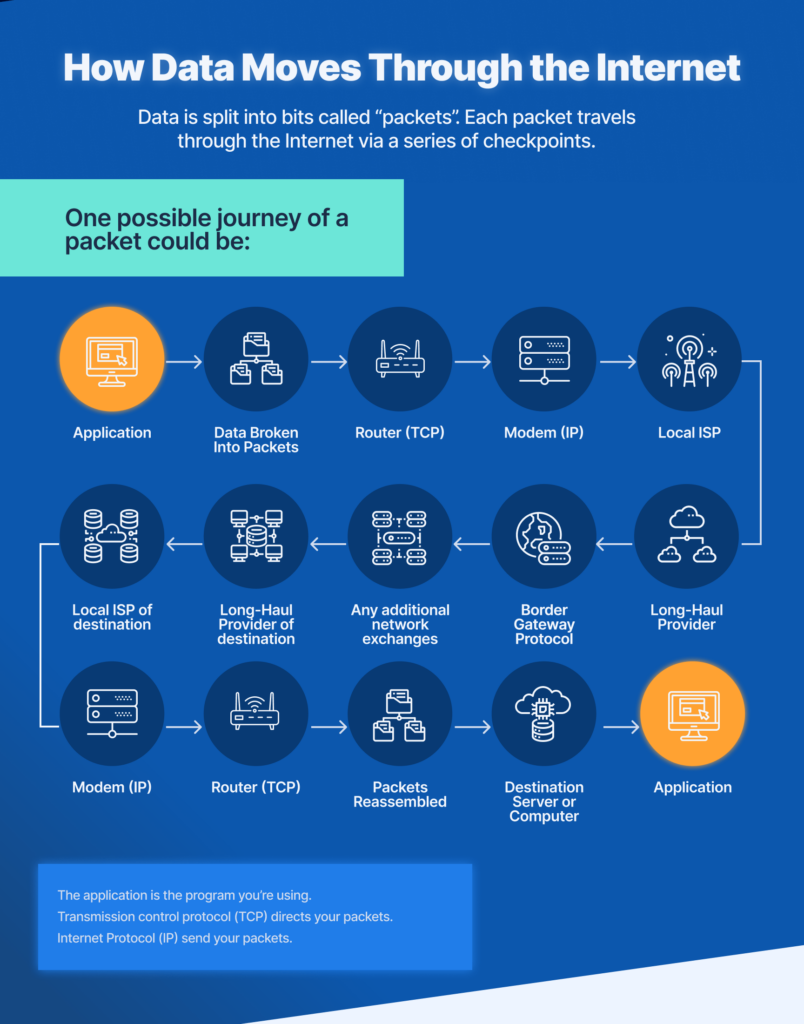 Then, your router uses a transmission control protocol (TCP) to direct your packets to their destination.
Then, your router uses a transmission control protocol (TCP) to direct your packets to their destination.
But there’s one problem — TCP isn’t good at actually sending packets. It can write an address on an envelope, but it can’t actually deliver the envelope. That’s why your modem uses Internet protocol (IP) to send your packets.
In other words, if TCP and IP worked in an office building, TCP would sort the mail in the delivery room and IP would deliver it throughout the building. With those two protocols working together, your packets can finally traverse the Internet. After your modem, the packets go to your local ISP, which directs it to your long haul provider.
Then, your packets go through border gateway protocol to a collection of enormous data exchange hubs (which we’ll discuss later). Then, the packets go to the destination’s long haul provider and the local ISP. Your packets also move through the modem and router of the destination location before getting reassembled.
Once reassembled, the information you sent finally arrives at the destination device, and your friend can see your message. That’s not exactly the route that your data takes every time you use the Internet — it’s just one of the countless other possibilities. The point is that no matter how quickly you can see information online, that data has a long way to go.
The Internet’s Domain Name System (DNS)
The Internet’s Domain Name System (DNS) is the way that pretty much everyone navigates the Internet.
DNS associates IP addresses with specific names. That lets you type “webfx.com” to find our website instead of 104.27.151.227. (And we may be biased, but we think “WebFX” is a little easier to remember than 104.27.151.227.) But DNS needs its own infrastructure to function — it can’t just exist because we want to use domain names. 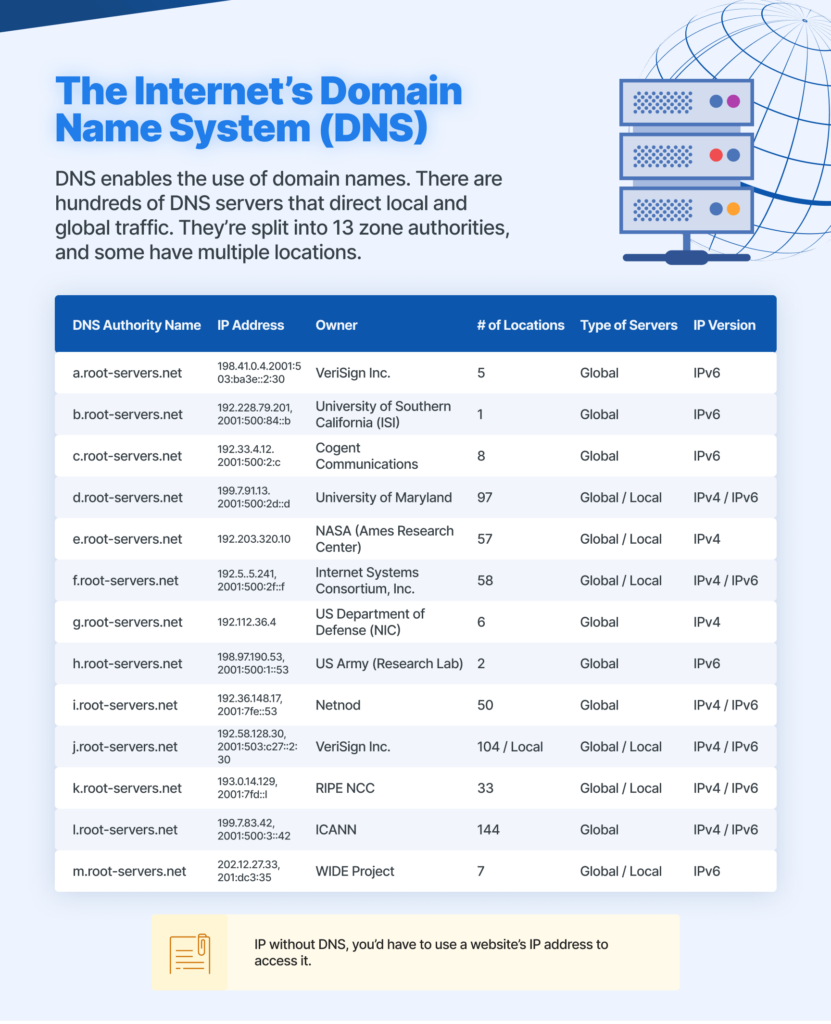 As a result, DNS has hundreds of different servers that empower the world’s domains. These servers are unevenly split into 13 “zone authorities” that serve global, local, IPv4, and/or IPv6 traffic.
As a result, DNS has hundreds of different servers that empower the world’s domains. These servers are unevenly split into 13 “zone authorities” that serve global, local, IPv4, and/or IPv6 traffic.
Global traffic is for requests that require data from a long distance. Local traffic is for requests nearby. Servers that use IPv4 serve “current generation” websites that were registered before the emergence of IPv6. IPv6 is the “next generation” of website IP addresses that allows for more numerical combinations and —as a result — more websites. (IPv6 was built exclusively to serve the growing number of websites on the Internet.) But who owns these 13 “zone authorities” anyway? What people or organizations are in charge of the Internet’s data transmission?
First, there’s VeriSign, Inc. VeriSign is a combination domain name and Internet security firm based out of Virginia. They’re the only organization to own two-zone authorities, but they don’t own the most server locations. Second, there’s the University of Southern California’s Information Sciences Institute (ISI).
USC is in Los Angeles and owns the fewest number of server locations. Cogent Communications owns eight locations throughout the world. Based out of Washington, DC, Cogent runs exclusively IPv6 servers, just like the previous two owners.
Next, University of Maryland owns nearly 100 different server locations throughout the world from their HQ in College Park. They also serve IPv4 websites and combination global / local traffic. NASA’s Ames Research Center also owns a handful of server locations that serve global/local traffic and IPv4 websites exclusively.
The Ames Research Center is based out of Moffett Field, California. The Internet Systems Consortium in Redwood City, California is the first non-profit on this list, and it owns 58 DNS server locations that serve global/local servers and IPv4 / IPv6 websites. ISC is partially responsible for the infrastructure of the Internet as a whole, and that’s basically all they do day-to-day.
In addition, the US Department of Defense Network Information Center owns six locations that serve IPv4 websites only. Interestingly, the DoD and NASA are the only two DNS zone authority owners that serve IPv4 only, while private sector owners at least serve both IPv4 and IPv6. Similar to the DoD, the United States Army’s Research Laboratory in Adelphi, Maryland owns two server locations that serve IPv6 only. Jumping back to the private sector, Netnod is an independent non-profit that supports the infrastructure of the Internet, similar to ISC. Netnod is headquartered in Stockholm, Sweden as well, making it the first non-American organization on this list.
Continuing with international organizations, Reseaux IP Europeens’ Network Coordination Centre controls nearly three dozen server locations that serve global, local, IPv4, and IPv6. RIPE NCC acts as the Internet registry organization for Europe, the Middle East, and some of Central Asia from offices in Amsterdam and Dubai. They’re also registered as a not-for-profit. Returning to America, the Internet Corporation for Assigned Names and Numbers is a nonprofit organization that supports the infrastructure of the Internet as well.
They own the most server locations with 144, and their organization’s members can actually update and change DNS according to a strict “keyholder” policy.
Finally, the Widely Integrated Distributed Environment Project is a major part of the Japanese Internet infrastructure. It’s the final organization on this list, and it controls seven server locations worldwide. But these are just servers and server locations.
To function as the Internet, they need to actually connect. The first step in doing this is to lay out miles upon miles of fiber optic cables.
The cables connecting the world
All of these servers need to connect in order for the Internet to function. And since Earth is mostly water, that leads to the problem of how.
Over the past few decades, we — collectively, as humanity — have laid more than half a million miles of cable throughout the world’s oceans. These cables are massive, and they’re responsible for international data transmissions. 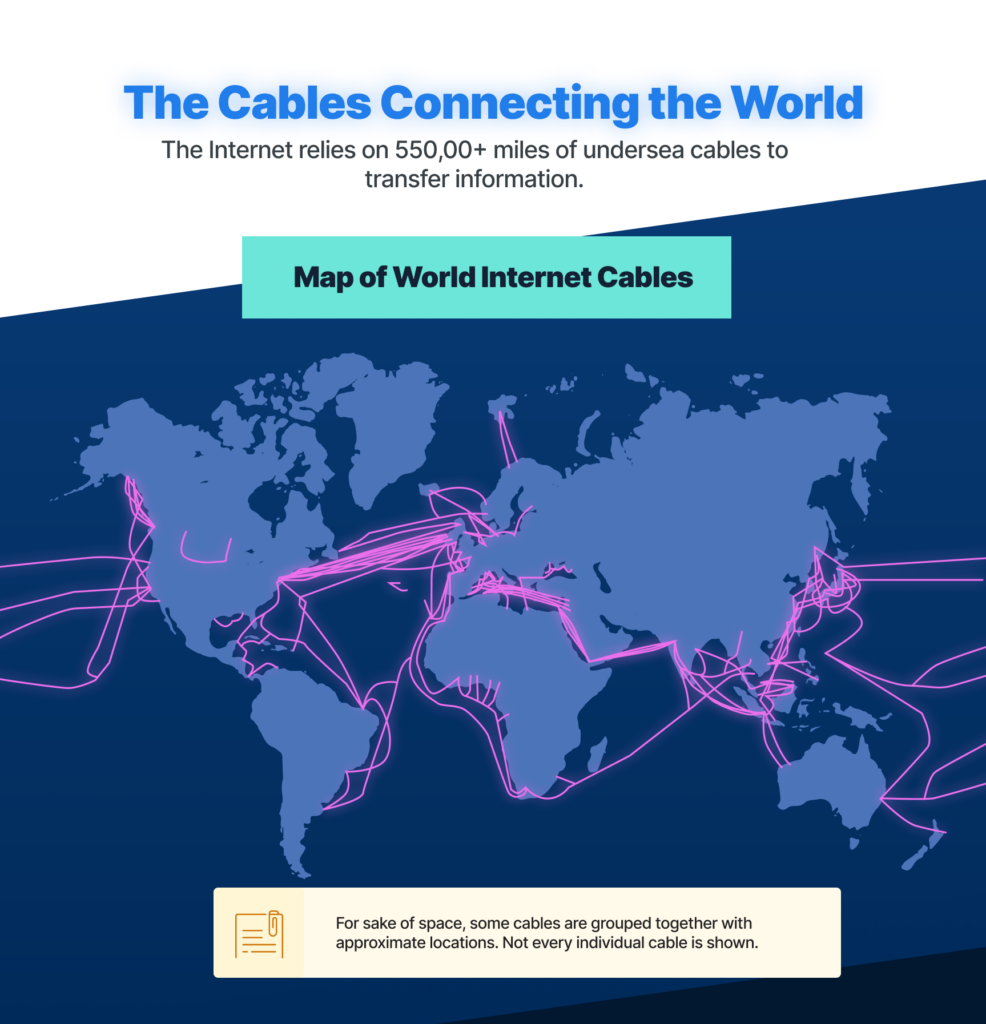 So if you’re in Quebec and you’re reading a website based out of Johannesburg, it’s because the ocean floors are lined with these thick, heavy cables.
So if you’re in Quebec and you’re reading a website based out of Johannesburg, it’s because the ocean floors are lined with these thick, heavy cables.
These cables have fiber optics inside that are responsible for transmitting actual data. But the fibers only make up a fraction of the thickness of a “submarine communications cable.” The rest of the cables are made of protective materials, as illustrated by this diagram courtesy of Wikimedia Commons.
The layers are:
- Polyethylene
- Mylar tape
- Stranded steel wires
- Aluminum water barrier
- Polycarbonate
- Copper or aluminum tubing
- Petroleum jelly
- Optical fibers
It may seem like overkill to band a thin bunch of optical fibers together in so much other material, but these cables are underwater. That means they have to stay safe from regular degradation, incredibly high pressure, and lots of animals (among other considerations). But at some point, the map above will be outdated.
The organizations responsible for these cables are constantly repairing them and laying new ones, bringing the world together with faster Internet speeds every year. And as more cables are laid, more of the world will find these cables on their beaches. At the time of publication, the United States is home to more cables than any other country in the world — especially when you also include non-state territories.
Map of US cables
Altogether, the United States has 101 cables on its shores.
That’s more than double any other country. A lot of these cables connect low-population areas, like the southern parts of Alaska or island territories. But they also connect the Atlantic and Pacific coasts of the continental US, which are the most populated areas of the country.
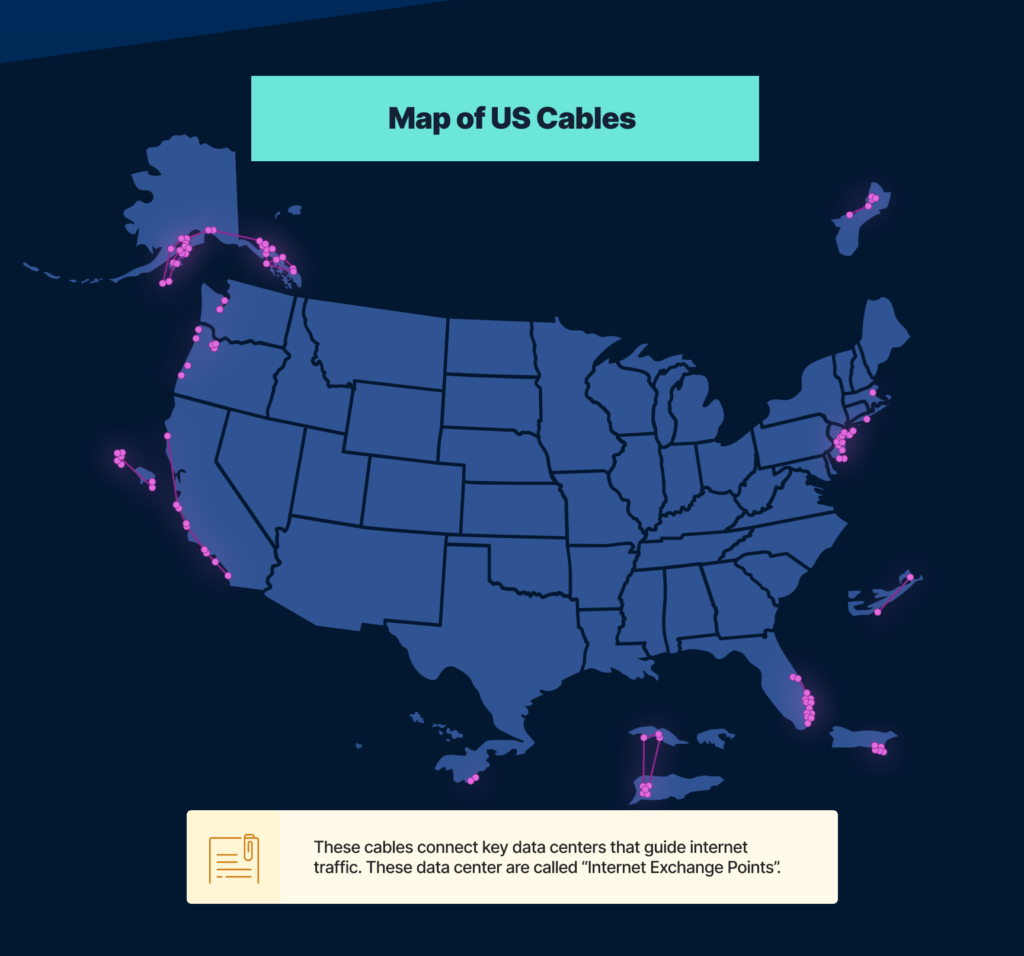 That’s why there are so many cables on the eastern seaboard, right near (or on) New York City’s borders. California has a string of cables that are connected along the shores of California as well. All of this makes sense when you look at the Internet speeds available in these areas, too.
That’s why there are so many cables on the eastern seaboard, right near (or on) New York City’s borders. California has a string of cables that are connected along the shores of California as well. All of this makes sense when you look at the Internet speeds available in these areas, too.
California has access to 2GB/s speeds, and areas like Delaware and Massachusetts can get 1GB/s speeds. That may not necessarily be because there are submarine communication cables in or near these states — but it’s at least an interesting correlation. But what’s even more interesting are the points that these cables connect.
World Internet Exchange Points
Internet Exchange Points are massive data hubs that process and direct packets of information.
At any given second, they’re moving gigabits of data, shooting it around the world with pinpoint precision. 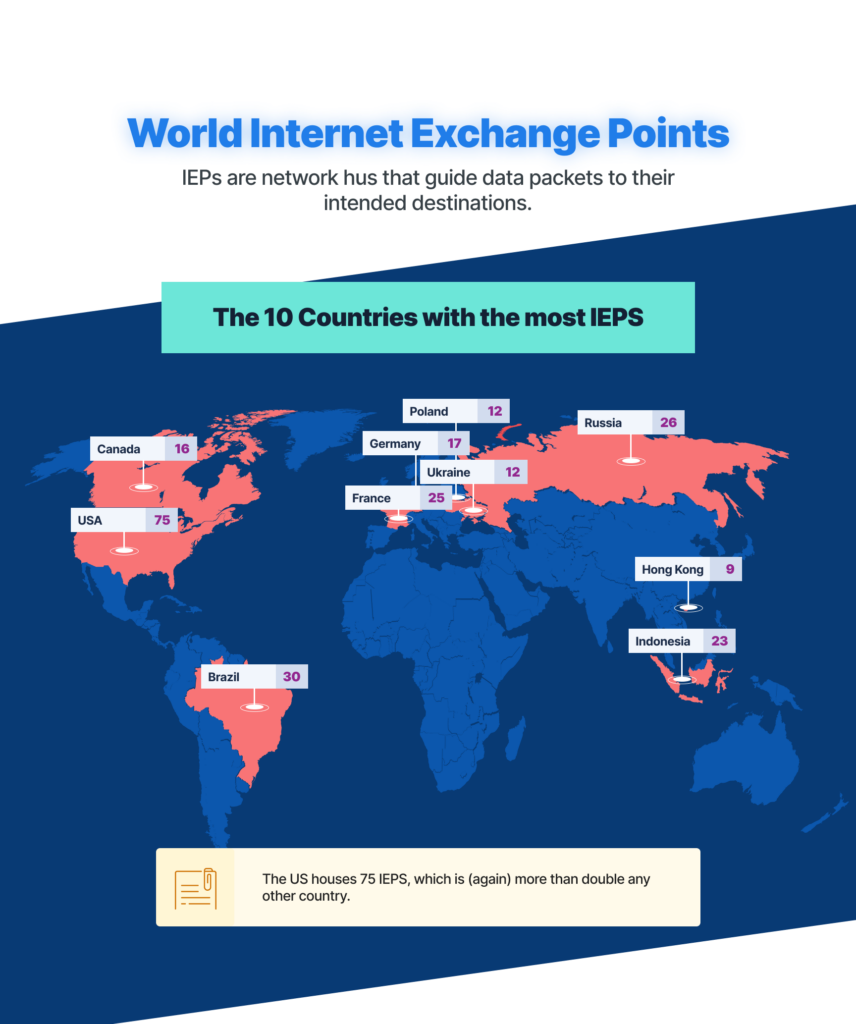 And while the above map only shows the 10 countries with the most IEPs, there are hundreds of others scattered throughout the world in Australia, Japan, and other areas. Still, the United States controls more than twice the number of IEPs than any other country.
And while the above map only shows the 10 countries with the most IEPs, there are hundreds of others scattered throughout the world in Australia, Japan, and other areas. Still, the United States controls more than twice the number of IEPs than any other country.
In fact, it’d take Brazil, Russia, and France combined — the next three countries on the list — to beat the US in terms of IEP count. But that doesn’t mean the US has the fastest Internet connections in the world. That distinction belongs to South Korea (desktop) and Vietnam (mobile).
Largest IEP groups in the world
IEPs are collected into groups that process the world’s Internet data.
These groups operate under one name, but they can have locations throughout the world. For example, DE-CIX has locations in Frankfurt, Hamburg, Munich, New York City, Dubai, Palermo, Istanbul, and Dallas. Likewise, LINX has locations in London, Edinburgh, and Northern Virginia.
And beyond that, NL-ix has locations in dozens of cities throughout the world. 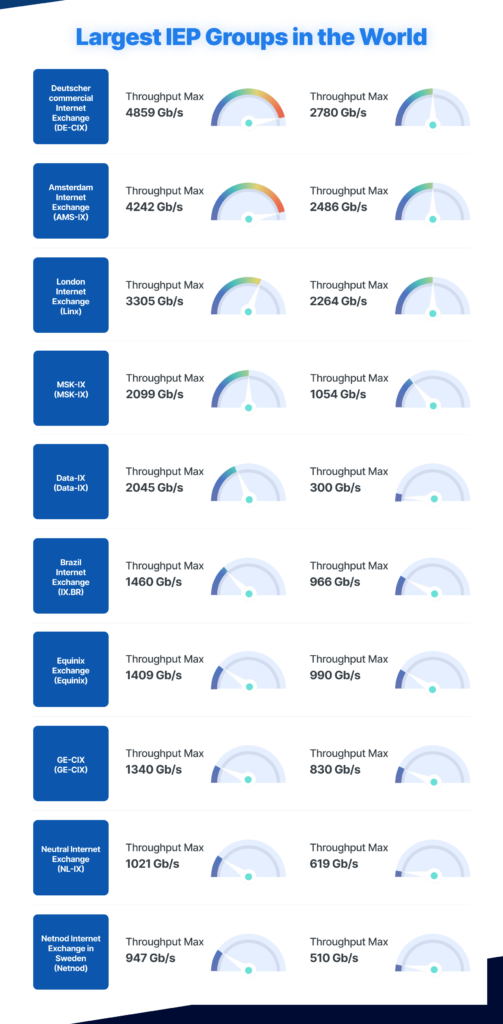 Still, some IEP groups include cities in one specific country. IX.br consists of Brazil-only cities.
Still, some IEP groups include cities in one specific country. IX.br consists of Brazil-only cities.
Others are regional. MSK-IX and DATA-IX includes cities only in Eastern Europe. And AMS-IX only includes cities in Western Europe.
So these points are peppered around the world, sometimes grouped by geography and other times almost at random. But without them, we wouldn’t have the infrastructure to use the Internet. IEPs are the reasons you can look at websites, play games, check your email, and do everything else you want online.
Without them, the Internet simply couldn’t exist. However, that’s just speaking in the present. The future of the Internet could look much different.
The Future of the Internet’s structure
Like all technology, the Internet is constantly evolving.
It improves with every passing year, however subtle the improvements may be. At the same time, the Internet has been around long enough that some people believe it’s time to take it to the next level. That’s why some of the biggest tech companies on Earth are taking a stab at Internet 2.0.
Google’s Project Loon
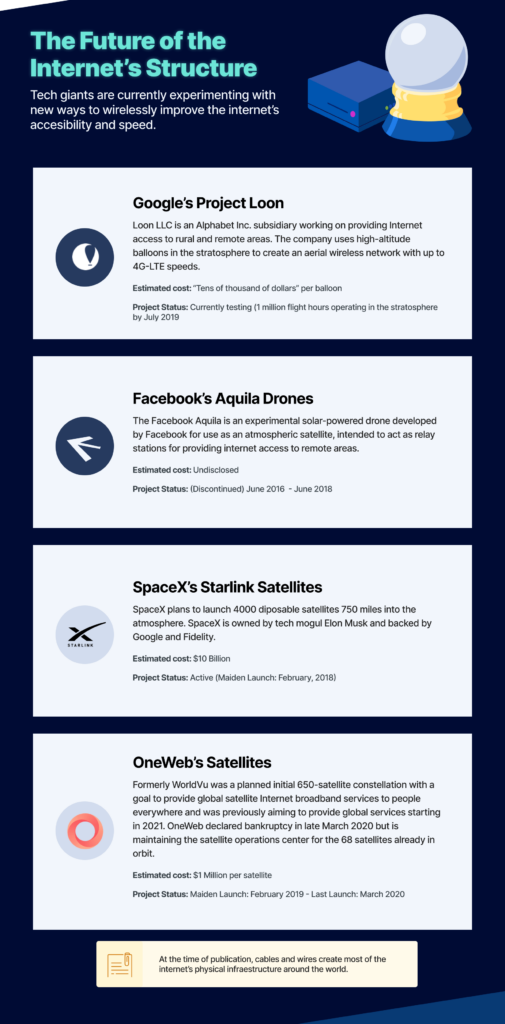
is a worldwide initiative headed by Google X.
Its ultimate goal is to deliver “balloon-powered Internet for everyone” in the world. Google plans to do this by creating an algorithm that predicts the movement of winds in the stratosphere. In the stratosphere, winds are layered on top of one another, going different speeds and directions.
So if Google wants to move a balloon somewhere to get Internet coverage, they can tell it to move up or down, and the planet’s natural wind patterns take care of the rest. Even for Google, that’s pretty ambitious. The stratosphere’s air pressure is 1% that of sea level, and there’s practically no protection from the sun’s ultraviolet radiation.
Plus, temperatures can get as low as -112 degrees. But — on the other hand — the stratosphere is high enough to keep balloons out of the way of wildlife, airplanes, and even weather. According to Project Loon’s website, Google plans to have each balloon “live” about 100 days in the stratosphere before engaging in a controlled descent back to the surface.
Below the balloon, a pair of solar panels will gather energy to power a small box of electronics that includes a battery to keep the balloons powered at night. Other electronics include circuit boards, antennas, and other communications essentials. Google’s balloons will share cellular communications bandwidth with phone service providers to ensure people can access the Internet on LTE-enabled devices, just like you would with a phone plan.
Google has already tested its Loon initiative in New Zealand’s South Island, which was an overall success. The testing is expanding over the coming years with no definite date on service.
Facebook’s Aquila Drones
is named after the Latin word for “eagle,” one of the largest birds in the world. And when you see the drones, it’s understandable why they chose the name.
Their wingspan is nearly 50 yards. That’s half a football field of robot. Facebook’s ultimate goal for their Aquila drones is to partner with Internet service providers to offer Internet connections to people in rural areas.
The drone acts as a middleman for ISP signals and users’ devices. That enables ISPs to reach areas that are otherwise inaccessible by communication wires. There’s no word on how much this service would cost — or how fast the Internet access would be — but it’s a step toward worldwide Internet service.
SpaceX’s Satellites
with satellites that are capable of delivering fast, affordable Internet service to developing or remote areas.
There’s not much known about SpaceX’s satellites right now, but they’re due to start testing this year. With that in mind, we’ll probably know more once they’ve launched something into orbit — including whether it works.
OneWeb’s Satellites
is probably the company that’s advanced the furthest with its next-generation Internet plans. Dr.
Paul E. Jacobs of Qualcomm Incorporated fronts OneWeb with an extensive board of directors that includes Richard Branson of Virgin and Thomas Enders of Airbus. OneWeb’s goal is to provide reliable Internet access to places experiencing natural disasters and other emergencies.
They also want to connect rural and underdeveloped areas, and maybe even beam broadband Internet to airplanes in midflight. OneWeb’s “constellation” of satellites will consist of microsatellites that are small, cheap, and easy to produce — at least compared to regular satellites. The idea is that there will be so many satellites in the air at a time that the whole world will have Internet access.
With a diverse range of high-profile investors like Coca-Cola, Virgin, Airbus, Hughes, and Qualcomm, OneWeb also has plenty of capital to achieve its goals. OneWeb is so advanced and confident in their capabilities that they’ve estimated they can offer service — not testing, but full-fledged Internet service — starting in 2019.
The Internet and you
We wouldn’t just throw something together without researching it first. If you want to see our data first-hand, you can check it out here.
Are you interested in all things Internet? Check out which country has the fastest Internet access in the whole world!
-
 The WebFX team is made up of more than 450 subject matter experts in digital marketing, SEO, web design and web development, social media, and more. Together, they’ve helped WebFX’s clients earn more than $3 billion in revenue from the web — and that’s just in the past five years.@webfx
The WebFX team is made up of more than 450 subject matter experts in digital marketing, SEO, web design and web development, social media, and more. Together, they’ve helped WebFX’s clients earn more than $3 billion in revenue from the web — and that’s just in the past five years.@webfx -

WebFX is a full-service marketing agency with 1,100+ client reviews and a 4.9-star rating on Clutch! Find out how our expert team and revenue-accelerating tech can drive results for you! Learn more
The Internet in Real Time
Ever wonder how much is going on at once on the Internet? It can be tough to wrap your mind around it, but we’ve put together a nice visual that’ll help! The numbers show no sign of slowing down either.
Find out More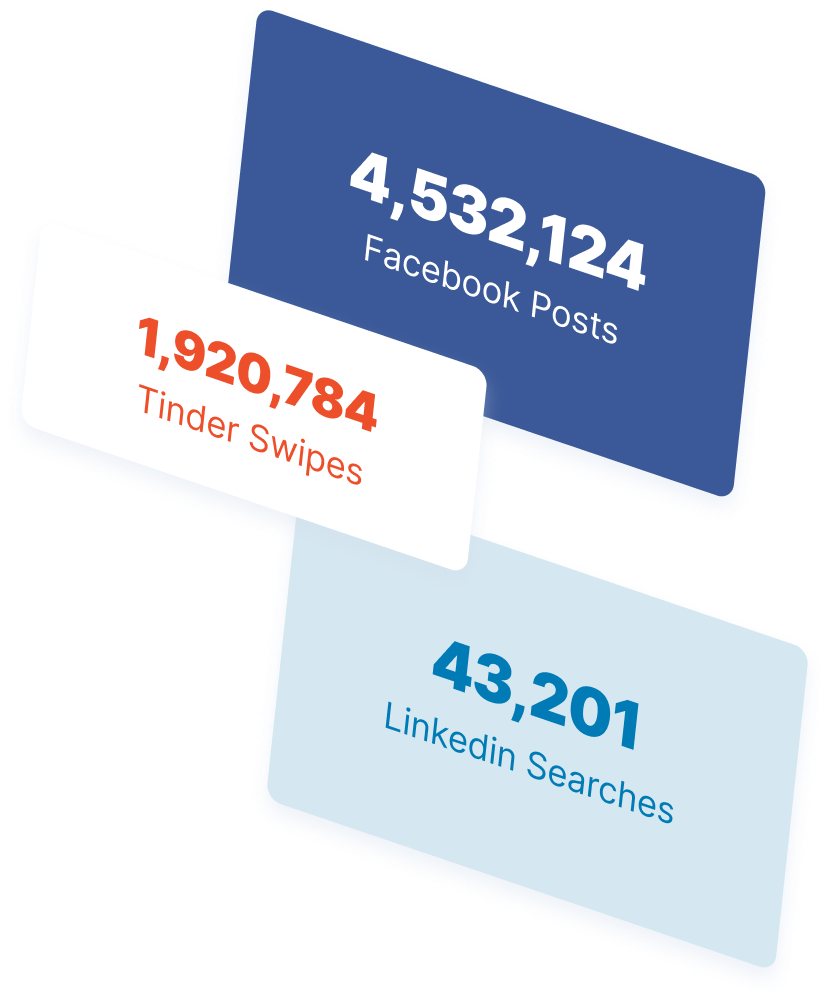

Ready to Drive Results for Your Business?
See how WebFX uses SEO, PPC, Social Media, and Web Design to Drive Revenue for Businesses.
Get InspiredThe Internet in Real Time
Ever wonder how much is going on at once on the Internet? It can be tough to wrap your mind around it, but we’ve put together a nice visual that’ll help! The numbers show no sign of slowing down either.
Find out More





